Indications of peep - Study guides, Class notes & Summaries
Looking for the best study guides, study notes and summaries about Indications of peep? On this page you'll find 314 study documents about Indications of peep.
Page 3 out of 314 results
Sort by
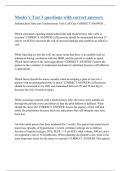
-
Mosby's Test 3 questions with correct answers
- Exam (elaborations) • 17 pages • 2023
- Available in package deal
-
- $13.99
- + learn more
Endotracheal Tube and Tracheostomy Tube Cuff Care CORRECT ANSWER ... Which statement regarding endotracheal tube and tracheostomy tube cuffs is accurate? CORRECT ANSWER Cuff pressure should be maintained between 27 and 41 cm H2O to decrease the risk of mucosal damage and establish an effective seal. While injecting air into the cuff, the nurse notes that there is no audible leak on inhalation during ventilation with the MRB, and the patient is unable to speak. Which intervention is the mos...

-
ATI RN Comprehensive Online Practice 2019 B with NGN Exam
- Exam (elaborations) • 34 pages • 2024
-
- $11.19
- + learn more
A nurse is caring for a client who is receiving positive end-expiratory pressure (PEEP) via mechanical ventilation. The nurse should monitor the client for which of the following adverse effects of PEEP? Hypoxemia Tension pneumothorax Malignant hypertension Atelectasis - ANS Tension pneumothorax The nurse should identify that tension pneumothorax is a possible adverse effect of PEEP. The nurse should monitor the client's lung sounds hourly for indications of a tension p...
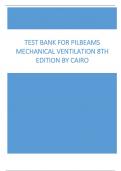
-
Test Bank for Pilbeams Mechanical Ventilation 8th Edition by Cairo
- Exam (elaborations) • 282 pages • 2023
-
- $20.49
- + learn more
Test Bank for Pilbeams Mechanical Ventilation 8th Edition by Cairo Table of contents Chapter 1. Basic Terms and Concepts of Mechanical Ventilation Physiological Terms and Concepts Related to Mechanical Ventilation Normal Mechanics of Spontaneous Ventilation Lung Characteristics Time Constants Types of Ventilators and Terms Used in Mechanical Ventilation Types of Mechanical Ventilation Definition of Pressures in Positive Pressure Ventilation Summary Chapter 2. How Ventilators Work Histo...
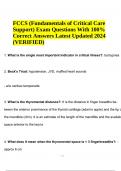
-
FCCS (Fundamentals of Critical Care Support) Exam Questions With 100% Correct Answers Latest Updated 2024 (VERIFIED)
- Exam (elaborations) • 93 pages • 2024
-
- $18.49
- + learn more
FCCS (Fundamentals of Critical Care Support) Exam Questions With 100% Correct Answers Latest Updated 2024 (VERIFIED) What is the single most important indicator in critical illness?: tachypnea 2. Beck's Triad: hypotension, JVD, muffled heart sounds - a/w cardiac tamponade 3. What is the thyromental distance?: It is the distance in finger breadths between the anterior prominence of the thyroid cartilage (adam's apple) and the tip of the mandible (chin). It is an estimate of the length of th...
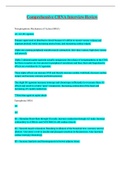
-
Comprehensive CRNA Interview Review Accurate responses are given.
- Presentation • 70 pages • 2023
-
- $18.99
- 3x sold
- + learn more
Comprehensive CRNA Interview Review Accurate responses are given. Comprehensive CRNA Interview Review Norepinephrine Mechanism of Action (MOA) A1, A2, B1 agonist. Primary agent used in distributive shock because it's ability to recruit venous volume and augment preload, while increasing arterial tone, and increasing cardiac output. Alpha one causing peripheral smooth muscle contraction. (low dose venous, high dose venous and arterial). Alpha 2 adrenoreceptor agonism actually ant...
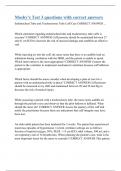
-
Mosby's Test 3 questions with correct answers
- Exam (elaborations) • 17 pages • 2023
-
- $14.99
- + learn more
Endotracheal Tube and Tracheostomy Tube Cuff Care CORRECT ANSWER ... Which statement regarding endotracheal tube and tracheostomy tube cuffs is accurate? CORRECT ANSWER Cuff pressure should be maintained between 27 and 41 cm H2O to decrease the risk of mucosal damage and establish an effective seal. While injecting air into the cuff, the nurse notes that there is no audible leak on inhalation during ventilation with the MRB, and the patient is unable to speak. Which intervention is the mos...
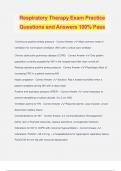
-
Respiratory Therapy Exam Practice Questions and Answers 100% Pass
- Exam (elaborations) • 11 pages • 2024
-
- $12.49
- + learn more
Respiratory Therapy Exam Practice Questions and Answers 100% Pass Continuous positive airway pressure - Correct Answer ️️ -Most common mode of ventilation for noninvasive ventilation (NIV) with a critical care ventilator Chronic obstructive pulmonary disease (COPD) - Correct Answer ️️ -Only patient population currently accepted for NIV in the hospital ward with near normal pH Raising expiratory positive airway pressure - Correct Answer ️️ -Physiologic effect of increasing FRC ...
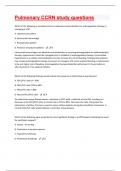
-
Pulmonary CCRN study Questions and Answers well Explained Latest 2024/2025 Update 100% Correct.
- Exam (elaborations) • 12 pages • 2024
- Available in package deal
-
- $7.99
- + learn more
Which of the following is considered to be an absolute contraindication for anticoagulation therapy in managing a VTE? A. Hypertensive patient B. Intracranial hemorrhage C. Postoperative patient D. Presence of epidural catheter - B Intracranial hemorrhage is an absolute contraindication to receiving anticoagulation or antithrombolytic therapy. Hypertension should be managed prior to initiation of anticoagulation therapy. Uncontrolled hypertension is a relative contraindication and can in...
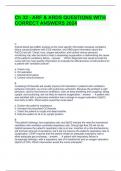
-
Ch 32 - ARF & ARDS QUESTIONS WITH CORRECT ANSWERS 2024
- Exam (elaborations) • 13 pages • 2024
- Available in package deal
-
- $19.49
- + learn more
Ch 32 - ARF & ARDS QUESTIONS WITH CORRECT ANSWERS 2024 C Arterial blood gas (ABG) analysis is the most specific information because ventilatory failure causes problems with CO2 retention, and ABGs give information about the PaCO2 and pH. Chest x-ray, oxygen saturation, and central venous pressure monitoring may also be done to help in assessing oxygenation or determining the cause of the patient's ventilatory failure. Which diagnostic test would provide the nurse with the most specific infor...
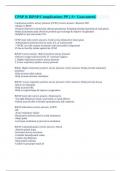
-
CPAP & BiPAP/Complications PP || A+ Guaranteed.
- Exam (elaborations) • 6 pages • 2024
- Available in package deal
-
- $10.69
- + learn more
Continuous positive airway pressure (CPAP) correct answers -Restores FRC -Similar to PEEP -Pressure delivered continuously during spontaneous breathing (during inspiration & expiration) -Helps pt maintain open alveoli to promote gas exchange & improve oxygenation -Helpful for pts who retain CO2 CPAP more info correct answers -Used to treat obstructive sleep apnea -Administered noninvasively by mask, ET, or tracheal tube -↑ WOB: use with caution in patients with myocardial compromise ...

Study stress? For sellers on Stuvia, these are actually golden times. KA-CHING! Earn from your study resources too and start uploading now. Discover all about earning on Stuvia


